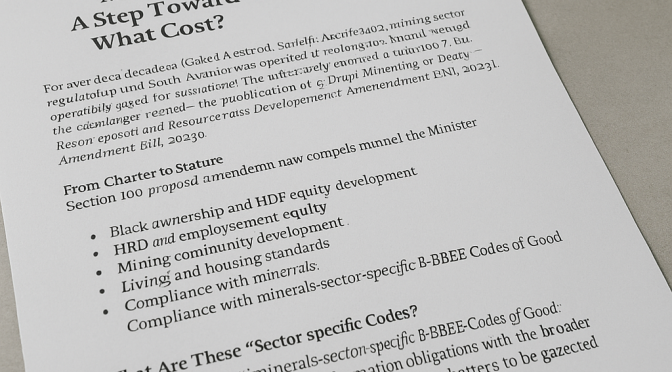For over two decades, South Africa’s mining sector has operated in a regulatory landscape shaped more by policy than by statute. The Mining Charter, introduced under the 2002 Mineral and Petroleum Resources Development Act (MPRDA), carried the weight of transformation—but not always the legal clarity or consistency to enforce it without contest. That tension is now under review with the publication of the Draft Mineral and Petroleum Resources Development Amendment Bill, 2025.
The headline shift is significant: Broad-Based Black Economic Empowerment (B-BBEE) elements will no longer sit primarily in the Charter—they’ll be embedded in the law itself.
From Charter to Statute
Section 100 of the proposed amendment now compels the Minister to include conditions tied to:
- Black ownership and HDP equity
- Inclusive procurement and supplier development
- HRD and employment equity
- Mining community development
- Living and housing standards
- Compliance with minerals-sector-specific B-BBEE Codes of Good Practice
In other words, what used to be housed in policy—and subject to frequent reinterpretation—is being elevated to legal requirement.
What Are These “Sector-Specific Codes”?
The reference to “minerals-sector-specific B-BBEE Codes of Good Practice” signals an effort to align mining transformation obligations with the broader B-BBEE Act (2003), which allows for sector-specific charters to be gazetted under national empowerment law.
Until now, the Mining Charter has served as a de facto sector code, but its status has always been slightly ambiguous—it was not formally gazetted under the B-BBEE Act, which made it vulnerable to legal challenge (as seen in the 2018 Minerals Council v Minister case).
The 2025 Bill likely anticipates one of two outcomes:
- Either the existing Mining Charter will be formally recognised and embedded through statute, or
- A new, properly gazetted sector code will be developed to give legal and procedural certainty to empowerment targets specific to the mining sector.
This brings the mining industry in line with other sectors—such as finance, construction, and agriculture—which already operate under formal B-BBEE Sector Codes with statutory weight.
In practice, this means that ownership, procurement, skills development, and community obligations will now be governed by mining-specific legal standards derived from both the B-BBEE Act and the MPRDA, with enforcement consequences tied directly to legislation—not policy interpretation.
Why This Matters
For mining professionals, this is more than just regulatory housekeeping. It marks a rebalancing of power between corporate discretion and state enforcement. It also shifts transformation from a condition of licensing (tied to policy) to an obligation in law (tied to statute), with implications for non-compliance that include fines, cancellations, and even criminal liability.
From a compliance standpoint, there is merit in this. For years, practitioners have worked in a grey zone—trying to meet targets that were binding in effect but unclear in law. The shift to embed empowerment criteria directly into the MPRDA reduces that ambiguity.
But Let’s Be Cautious
While legal clarity is welcome, embedding B-BBEE targets into primary legislation reduces flexibility. Unlike the Charter, which can be adjusted through ministerial process, amendments to the Act require a full legislative cycle—often slow and politically charged.
This raises some critical questions:
- Will the Act now lock in transformation targets that may need refinement over time?
- How will industry innovation in transformation be accommodated under a more rigid legal regime?
- Could regulatory overreach—well-intentioned but inflexible—create unintended barriers to investment?
There’s also the compliance burden. Aligning with codified legal obligations will likely mean increased due diligence, cost structures, and internal audits. This may be manageable for larger entities—but challenging for mid-tier or emerging operators.
What We Can Agree On
Despite reservations, the direction is clear: transformation is no longer just a policy preference—it is becoming law. And with that, comes clearer lines of accountability and a more consistent baseline across the sector.
For those of us in SLP and ESG strategy, this development underscores the need to stay ahead of compliance—not just through tick-box reporting, but through strategic alignment with evolving legal expectations.
This amendment doesn’t solve all the problems—but it does acknowledge a longstanding one: that policy without statutory force is too easy to ignore.

